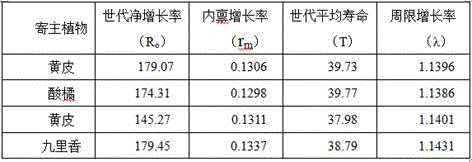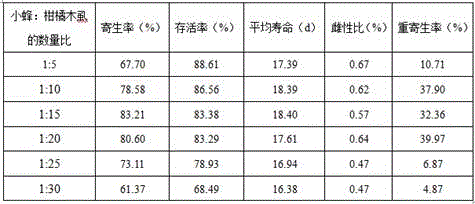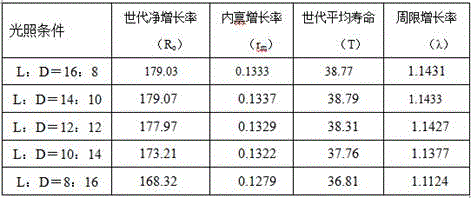Large-scale breeding method for tamarixia radiate
A technology of the glazed bee and the glazed bee, which is applied in the field of biological control of agricultural and forestry pests, can solve the problems of difficult artificial breeding of the bright glazed bee adults, the inability to supply quantitatively throughout the year, and the inability to store in refrigerators, so as to solve the problem of insufficient supply, Low cost, high quality effect
- Summary
- Abstract
- Description
- Claims
- Application Information
AI Technical Summary
Problems solved by technology
Method used
Image
Examples
Embodiment 1
[0046] Embodiment 1 The large-scale propagation method of bright belly glaze wasp
[0047] 1. A large-scale breeding method of the bright-bellied glazed wasp, the method is mainly completed in divisions in four greenhouses of the host plant cultivation room, insect culture room, bee pupa collection room and breeding bee room, and the specific steps are as follows:
[0048] (1) Cultivation and management of host plants
[0049] To buy disease-free and robust Gili japonica seedlings with a height of 40-60cm in the market, first trim the Gili jasmine seedlings. When pruning, remove the terminal buds to break the dominance of the top; then soak them in 5% bleach solution for 10 minutes, or spray mineral oil to kill them. Insecticides remove insects and germs on the mulberry seedlings; transplant the mulberry seedlings in batches to the host plant cultivation room for potting, the temperature in the cultivation room is 22-28°C, RH60%-75%, and the light L:D=14 : 10, after the young...
Embodiment 2
[0072] Example 2 Host Plant Selection
[0073] 1, a kind of large-scale propagation method of bright-bellied glaze wasp, this method is mainly completed in division in four greenhouses of host plant cultivation room, insect culture room, bee pupa collection room and breeding bee room, and its concrete steps are with embodiment 1, The only difference is that the host plants are grapefruit, sour orange, and yellow peel.
[0074] 2. The results are shown in Table 1
[0075] Table 1 Comparison of adaptive parameters of citrus psyllids on different host plants
[0076]
[0077] 3. Comprehensive comparison
[0078] Table 2 Biological table of citrus psyllids on different host plants
[0079]
[0080] In summary, the egg-adult development time of citrus psyllids on Jiulixiang seedlings is relatively short, the survival rate is relatively high, and there is no significant difference in the ratio of male to female. The intrinsic growth rate of citrus psyllid was the highest o...
Embodiment 3
[0081] Embodiment 3 Lighting condition optimization
[0082] 1, a kind of large-scale propagation method of bright-bellied glaze wasp, this method is mainly completed in division in four greenhouses of host plant cultivation room, insect culture room, bee pupa collection room and breeding bee room, and its concrete steps are with embodiment 1, The only difference lies in the different light conditions in the citrus psyllid insect culture room.
[0083] 2. The results are shown in Table 3
[0084] Table 3 Comparison of adaptive parameters of citrus psyllids under different light conditions (the host plant is Murata japonica)
[0085]
[0086] 3. Comprehensive comparison
[0087] Table 4 Biological table of citrus psyllid under different light conditions (the host plant is Murata citrus)
[0088]
[0089] To sum up, when the light conditions in the entomology room were L:D=14:10, the development time of citrus psyllid eggs-adults was relatively short, the survival rate ...
PUM
| Property | Measurement | Unit |
|---|---|---|
| Height | aaaaa | aaaaa |
| Aperture | aaaaa | aaaaa |
Abstract
Description
Claims
Application Information
 Login to View More
Login to View More - R&D
- Intellectual Property
- Life Sciences
- Materials
- Tech Scout
- Unparalleled Data Quality
- Higher Quality Content
- 60% Fewer Hallucinations
Browse by: Latest US Patents, China's latest patents, Technical Efficacy Thesaurus, Application Domain, Technology Topic, Popular Technical Reports.
© 2025 PatSnap. All rights reserved.Legal|Privacy policy|Modern Slavery Act Transparency Statement|Sitemap|About US| Contact US: help@patsnap.com



